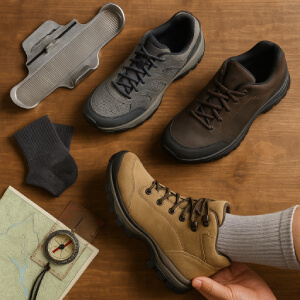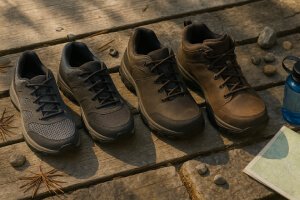Right hiking shoes can make or break your outdoor experience. Ill-fitting or unsuitable shoes can cause discomfort, injuries, or even cut an adventure short. With options ranging from lightweight trail runners to rugged boots, it’s important to assess terrain and personal needs before buying.
This guide will walk you through the key factors to consider, helping you choose shoes that prioritize comfort, support, and durability, so your hikes are safe and enjoyable.
Understanding Your Hiking Needs
Shoe options come next! But first, one must ask, “What are my hiking needs?” Trails all have their own character; hence, a choice in footwear depends on the exertion level, terrain, and climatic conditions.

Consider the Terrain
One does not hike on the same terrain every day, nor do they wear the same set of shoes. Light shoes are for well-drained dirt or paved trail. On the other hand, rocky terrains require stiffer soles, greater friction, and perhaps better ankle support. A wet and muddy trail requires shoes that will keep your feet dry. Matching your footwear with the terrain presence ensures avoiding from slipping, ankle-twisting, or shoe-damaging.
Think About Hike Duration and Load
The duration for your hikes and the weight the shoes bear enter into consideration, too. A day hiker with minimal gear values being lightweight and flexible. Long-distance bull-doggers, on the other hand, require more support and cushioning from their mountings. Thorough consideration of such things allows one to make a tradeoff between comfort and functionality.
Types of Hiking Shoes
Hiking shoes come in a variety of types, each suited to specific environmental demands. It is necessary to understand the differences between various hiking shoes before making a choice.
Hiking Shoes
These shoes are low-cut, lightweight and suitable for well-maintained trails and moderate terrain. They basically provide the elements of comfort, flexibility and breathability but less ankle support; the suitable hiking shoes for an easy day hike or casual walk in the park or through the woods.
Hiking Boots
Medium- and high-cut hiking boots provide more ankle support and protection but are heavier and better suited for rough trails, uneven terrain, and heavy backpack loads. Often waterproofed and rugged-soled, boots can withstand the rigours of tough conditions.
Trail Running Shoes
Trail runners are lightweight and highly breathable, with flexible soles engineered for speed and agility. They are really the best choice for well-maintained trails, fast hikes, or hikers who find comfort more imperative than protection. While they afford less ankle support than boots, quite a few hikers choose them because they are lighter in weight and versatile.
Fit and Comfort: The Most Important Factors
Now, expensive shoes mean very little if they do not fit. Comfort takes precedence.

Measuring Your Foot
Late messuring times shall always be when selecting hiking shoes; one foot is usually larger than the other. Measure the length as well as the width and make sure your toes do not hit the shoe. Your heel should fit snugly so as to avoid blisters, while the toe box can be a little loose to allow for swelling of your feet during long hikes.
Trying Them On
Try shoes with the socks you intend to hike with. If the trail is uneven, try to follow that pattern of motion so as to simulate hiking conditions. Remember that different materials may stretch with use, while waterproof shoes tend to feel stiffer at first. Testing the shoes in real hiking conditions aids in locating points where pressure could come into play, thereby ensuring comfort for the long haul.
Sole, Grip, and Stability
The sole of your hiking shoe dictates both the traction and shock absorption and, hence, the general stability of the shoe and these two properties are immensely important when it comes to safety and performance.
Outsole Material and Tread
Rubber outsoles with deep lugs provide excellent traction on rocky or muddy terrain. One must also consider the type of tread: aggressive patterns offer traction for steep or loose trails, while smoother soles are adequate for easy routes. Look for durable rubber compounds that resist wear and tear.
Midsole Cushioning
The midsole cushes, absorbs, and reduces the shock that might cause fatigue, finally protecting the joints. Commonly used materials for the midsoles are EVA and polyurethane, and they each provide a different amount of support and sole life. For hiking across uneven terrain, shoes with firm midsoles are preferred for stability.
Flexibility and Stability
Strike the right balance between flexibility and stability as per your requirement. Flexible shoes enable natural movement and offer comfort on smooth trails. Stiffer soles provide support on rocky or uneven terrains and protect you from twisting your ankle. The choice depends on where you usually do most of your hiking.
Weight and Breathability
Hiking shoes strike a balance between protection and weight. Lighter shoes reduce fatigue on longer distance hiking while heavy shoes offer protection and support.

Lightweight Shoes
Great for fast day hikes or easy trails, lightweight shoes improve agility and lessen the strain on your feet but offer limited protection on rough terrain.
Breathable Materials
Drying wet feet is tantamount to preventing blisters and smells. Mesh panels and moisture-wicking liners only help ventilation in warm weather. Please do consider shoes that are waterproof and breathable for the wet conditions.
Waterproofing and Weather Considerations
There is a big emphasis on weather there as the other shoe is being selected. Waterproof shoes are simply for rainy environments, while well-ventilated ones are better suited for hot and dry ones.
In actuality, waterproof shoes nowadays have membrane materials like Gore-Tex or similar that keep water out but allow moisture from the inside (sweat) to escape. Very good concept but sometimes in the heat, they feel less comfortable. In any event, if you enter streams or snow, waterproofing is a must.
Find Your Perfect Fit
Choosing the right hiking shoes comes in trade-off between terrain, activity level, and personal comfort. Look into shoe type and fit, sole, materials, and compatibility with weather. They may hurt or tire you down if you do not know your requirements and invest accordingly, and you will not be able to enjoy with every step you take on a hike. Taking care of them will be an added benefit to their life span and performance.
